Hacksaw Ridge
 for intense prolonged realistically graphic sequences of war violence including grisly bloody images.
for intense prolonged realistically graphic sequences of war violence including grisly bloody images.
Reviewed by: Curtis McParland
CONTRIBUTOR
| Moral Rating: | Average—with strong caution |
| Moviemaking Quality: |
|
| Primary Audience: | Adults |
| Genre: | Biography War History Romance Drama |
| Length: | 2 hr. 11 min. |
| Year of Release: | 2016 |
| USA Release: |
November 4, 2016 (wide—2,886 theaters) DVD: February 21, 2017 |
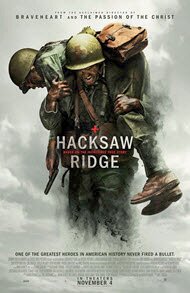

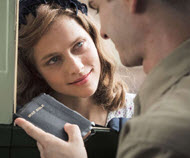


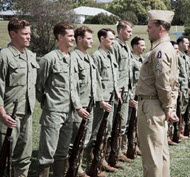

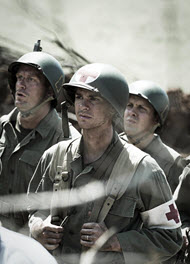
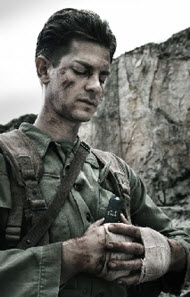
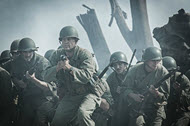
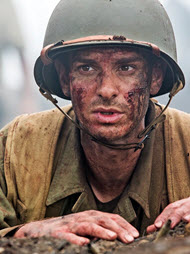
conscientious objectors
pacifism
The 6th Commandment to the Israelites says, “You shall not MURDER,” not you shall not KILL.
What is the Biblical perspective on war? Answer
war in the Bible
bravery / courage / self-sacrifice
standing up for what you believe
FILM VIOLENCE—How does viewing violence in movies affect families? Answer
“The project was originally brought to Hollywood by screenwriter/producer Gregory Crosby through the efforts of Stan Jensen of the Seventh-day Adventist Church” (Wikipedia). In 2004, Doss was the subject of a Pax TV docudrama, “The Conscientious Objector.”
| Featuring |
|---|
|
Andrew Garfield … Desmond T. Doss, WWII American Army Medic (a Corporal) Teresa Palmer … Dorothy Schutte Hugo Weaving … Tom Doss Sam Worthington … Captain Glover Luke Bracey … Smitty Vince Vaughn … Sergeant Howell See all » |
| Director |
|
Mel Gibson |
| Producer |
|
AI-Film Argent Pictures See all » |
| Distributor |
“But they who wait for the Lord shall renew their strength; they shall mount up with wings like eagles; they shall run and not be weary; they shall walk and not faint” (Isaiah 40:31). These are just a few of the many words of Scripture shared by Desmond T. Doss (Andrew Garfield) in the opening scene of “Hacksaw Ridge.” As soldiers get riddled with bullets, blown by grenades, and set ablaze, Desmond’s soothing voiceover shines a light and reassures the audience that there is in fact a God who is always watching over us. “Hacksaw Ridge” shares the true story of Desmond Doss, a conscientious objector in WWII and how he came to save over 75 lives in one of the bloodiest battles in history, the Battle of Okinawa, without ever bearing arms.
Desmond grew up as a Seventh-Day Adventist, observed the Sabbath on a Saturday, and had a strong faith in God. Desmond did not have a perfect family life, by any means, though, as his father was an abusive alcoholic, and both Desmond and his brother Hal would get in frequent fights as young boys. However, one fight got out of hand, resulting in Desmond nearly killing his brother by striking him in the face with a brick. This moment was a turning point in Desmond’s life, as he observed a portrait of the Ten Commandments in his family home. The Sixth Commandment spoke greatly to him: “Thou shalt not kill.” With a tear-streaked face, Desmond turns to his mom and says “I could have killed him.”
Years pass by, and Desmond meets the love of his life, Dorothy (Teresa Palmer) at a hospital. But before they marry, Desmond enlists in the military and begins his journey as an army medic. However, little does he realize that his faith and convictions may conflict with the rules of the military. Everything begins to go downhill for Desmond when he arrives at camp. He refuses to touch any form of weapon and will not partake in any act of violence, since it goes against his beliefs. His commanders want him kicked out, but Desmond wants to stay, because he believes this is what he was called to do: to serve his country. Desmond even tells his father, “While everyone else is taking life, I’m going to be saving it. And that’s how I’m going to serve.” Through pain, trial, and suffering, Desmond faces grave humiliation and even potential imprisonment. But little does he know that this is just one small part of his journey and only God knows what lies ahead for him and every other soldier out on the battlefield in the midst of Hacksaw Ridge.
“Hacksaw Ridge” is a compelling, mind-blowing, and even tear jerking war film from acclaimed director Mel Gibson (“Braveheart,” “The Passion of the Christ,” and “Apocalypto”). The script is very well written and contained few flaws, in my opinion. Brief moments of dialog feel a little weak and more development on Doss becoming a medic would have been interesting. Still, the film is excellently paced, filled with strong performances, and some characters provide very brief and light comedic relief. Gibson proves to be a very strong filmmaker and does an excellent job of developing his characters. All around, the performances are near flawless, and the cinematography and sound design are wonderfully executed. “Hacksaw Ridge” will most likely go down as Mel Gibson’s best film and one of the best war films since “Saving Private Ryan.”.
The sexual content is kept to a minimum. Both married and unmarried couples kiss on several occasions, a soldier reads a pin-up magazine (nothing explicit is shown), and a drill sergeant tells soldiers that their guns should be their “lovers, mistresses, and concubines.” One soldier says he never knew his father, but that it was most likely one of ten guys. After getting married, a brief and tender scene takes place in Desmond and Dorothy’s bedroom. Desmond is shirtless, and Dorothy wears a very modest nightgown. The couple passionately kiss, and Dorothy tells him, “You better come home to me.” The scene cuts away as they fall out of frame. One soldier is labeled as an exhibitionist, and we see him naked from behind as he does chin-ups in his tent. Soldiers crack jokes about his anatomy, and, after roll is called, a drill sergeant forces the same man to run through a training course naked, as he has no time to get dressed. His privates are obscured, but we do catch a few more glimpses of his bare rear. One crude reference is made about female anatomy.
For a war film, the language is relatively mild, as we hear around a half-dozen uses each of s- and a-words and multiple uses of h*ll. A small handful of additional mild obscenities include d*mn, sc**w, p*ss, and b**ch. The phrases “Good Lord” and “For God’s sake” both pop up once each. However, it’s hard to discern if they are being used as profanities or not. The Japanese are referred to as “japs” and “nips” on a number of occasions, and women are sometimes called “dames” and “broads.” One character calls another a “chowder head.”
War is hell. And Mel Gibson gives us a harrowing depiction of war, as we see mounds of grisly, bloody images. Soldiers are riddled with bullets from head to toe, as blood spurts from their bodies. Numbers of soldiers lose various limbs and body parts on impact, and others explode into thin air as they are hit with grenades. Some are stabbed and impaled by the enemy or bludgeoned. One American soldier is killed execution style. We only hear what happens, though. One soldier picks up the top half of a dead soldier and uses it as a shield from enemy gunfire. Another uses a body to shield himself from a grenade, just before it explodes. Two men explode together, as they fight hand to hand while one of them holds a live grenade.
There is plenty of hand to hand combat, as soldiers punch, stab, and strangle each other. Many men burn to death as flamethrowers spew fire across the battlefield. Soldiers lose flesh, pieces at a time, and even intestines and organs spill out as many cry out in agony. The amount of bloody carnage (entrails and all) is mind-boggling, but no doubt an accurate depiction of the horrors of war. There are countless images of dead and wounded soldiers. Rats and insects feed on the flesh of rotting corpses, and many bodies are shown in gruesome detail. A Japanese soldier is seen dead, hanging. Another performs a form of ritual suicide where he stabs himself in the gut and let’s another behead him. Numbers of soldiers are injected with morphine needles.
Some violence takes place off the battlefield, too. While still at camp, one soldier kicks Desmond in the face when running through a training course and punches him one other time. Another scene involves Desmond being pulled out of bed in the middle of the night and getting beaten by a few of his comrades. A story is shared of how a soldier was shot through the back and how messy the wound was. When placed in a military cell, a frustrated Desmond beats the cell wall violently and flips his bed frame. As mentioned above, Desmond’s father was an abusive alcoholic. We hear sounds of abuse on two occasions as Desmond’s father, Tom, screams and yells in a drunken rampage at the boy’s mother, Bertha. ***SPOILER*** One scene involves Desmond coming to the rescue when Tom has a gun in hand. Desmond takes control of the gun and Tom begs him to shoot him to put him out of his misery. Of course, Desmond doesn’t listen. ***END SPOILER***
The two young Doss boys get into some scuffles, and, as I mentioned above, one scene involves hitting his brother in the face with a brick. We see bruising and some blood. One additional scene features a very bloody leg wound when we see a young man laying on the ground in agony after a truck falls on him. Desmond ends up saving the man’s life. A man cuts his hand after smashing a glass bottle, and we see a fair amount of blood. We see a man getting stuck with needle when donating blood.
Alcohol content is limited to Tom Doss’s character, as he struggles with alcoholism and takes a few swigs of strong liquor. A few soldiers smoke cigarettes and in one scene we see a soldier vomit.
“Finally, be strong in the Lord and in the strength of his might.” —Ephesians 6:10 (ESV)
“Hacksaw Ridge” is filled with strong Christian themes, as Desmond firmly stands behind his beliefs and convictions. Although the Gospel message is not clearly conveyed, Desmond is still a man who is not ashamed of his faith and always looks towards God for guidance and direction. Director Mel Gibson gives us an excellent portrayal of a God-fearing man and how he lives out his faith. The film shares that faith isn’t easy and that it is also a journey. Christians will be mocked, ridiculed, and even feel abandoned at times. But if we have a God who is for us, who can stand against us?
“What then shall we say to these things? If God is for us, who can be against us?” —Romans 8:31
“Hacksaw Ridge” reveals how a man’s faith and courage saved over 70 lives, and how it impacted hundreds (and eventually thousands) of lives. As the film’s story develops, we begin to witness a gradual change in many of the characters, as they turn from harsh and bitter, to respectful and even somewhat kind towards Desmond. Desmond was always viewed as “different” by the other men, but they slowly learned that this type of “different” is a beautiful thing. They saw a light shining through him, as he respected his God by not partaking in any acts of violence. They saw a man who wanted to save life, not take it. They saw a man who loved others no matter how much he may was mistreated. But most of all, they saw a man who forgave others and loved the Lord with all of his heart. Before the men headed into another battle, they respectfully waited for Desmond as he prayed for them all. Although Desmond went to “work” on the Sabbath, he still didn’t let the war get between him and his relationship with God. We see him reading his Bible and praying on countless occasions.
“For we walk by faith, not by sight.” —2 Corinthians 5:7
Although “Hacksaw Ridge” contains many powerful faith-based themes and shares the story of a man who lived out his Christian faith, I cannot recommend this film to family audiences, due to its graphic war violence and moments of vulgar language. This film certainly isn’t for the faint of heart, as the body count is ridiculously high, and the bloodshed is near constant in the second half of the film. However, for those who are fans of war films and can tolerate such strong violence, I do give this film a recommendation, since it has such a powerful Christian message. I am certain that a good number of Christian audiences would appreciate the hard work and effort put into this film and the wonderful Christian themes it shares.
“Hacksaw Ridge” is masterfully crafted, and the violence itself I found to be quite necessary to accurately depict the horrors of war. It may be intense, prolonged, and realistically graphic, but it isn’t mindless like most other “R” rated action or slasher films. Like “Saving Private Ryan,” I believe “Hacksaw Ridge” is a necessary film for some to see. But please use very strong discretion before viewing this film. Not only does “Hacksaw Ridge” deliver a harrowing depiction of war and tell a beautiful story of heroism, but it shares how a Christian served his country and his God during one of the bloodiest battles in history. Most importantly, though, it shares how he lived out his faith without ever firing a single bullet. “Hacksaw Ridge” may very well be one of the most violent films released this year, but it is also one of the most essential. It shares that, although we may live in a corrupt and violent world, there are still plenty of good people in it, and there is a God who will never leave us or forsake us. Just like God called Desmond onto the battlefield to save lives, He is calling us to serve Him to do what we may think is the impossible. But the big question is: Are you ready to answer His calling? Are you ready to take that leap of faith?
“Be strong and courageous. Do not fear or be in dread of them, for it is the LORD your God who goes with you. He will not leave you or forsake you.” —Deuteronomy 31:6
Violence: Extreme / Profanity: Moderate—“Swear to G*d” (1), “For G*d's sakes” (1), “Good L*rd” (1), “Jesus Christ” (1), “hell” (15+), “damn” (4) / Sex/Nudity: Moderate to Heavy
See list of Relevant Issues—questions-and-answers.


The film is rated R due to the intensity of the blood and gore in the war scenes, but such scenes do not serve as gratuitous violence, but rather set the context for the trial and testing of the Christian character’s faith. In the brief scene showing the main character in the marital bed on his wedding night, the scene has a close-up of the wedding ring as if to emphasize the covenant aspect of marriage. There are also a few scenes of symbolic spiritual intensity reminiscent of baptism and resurrection. This film in some ways is like a “Pilgrim’s Progress” for our time.
Moral rating: Good / Moviemaking quality: 5
Moral rating: Excellent! / Moviemaking quality: 5
His love for mankind is clearly shown by him not only saving his fellow soldiers, but helping wounded enemy soldiers as well. It is this love that reaches our enemies and helps bring people out of the darkness of hate.
I strongly recommend this movie to all audiences with the exception of children. Teens may be old enough to handle the graphic nature of the movie, but every parent should make that decision with caution.
Moral rating: Better than Average / Moviemaking quality: 5
CONTRIBUTOR does not do the film justice. I would not bring a young child to see this, but anyone past the age of 13 would be fine. This is the most Christian movie I've seen at a theater. The hero is a true christian hero who sticks to his values despite severe persecution. Also, its a TRUE story. Don't miss this movie. I took my wife and daughter. They protested that they did not want to see a war movie. After the movie, they both said they loved the movie.
Moral rating: Excellent! / Moviemaking quality: 5
I can’t remember a more powerful movie, in my opinion, in a decade. One of the most powerful I’ve seen… because it’s based on a true story. Garfield, hopefully, will be considered at award’s time, as should Hugo Weaving, who portrayed his father. Everyone was very good. Good to see Vince Vaughn in something of substance, even. Thank you to Mel Gibson, and everyone who had a hand in bringing this story to us.
Moral rating: Good / Moviemaking quality: 5
Moral rating: Excellent! / Moviemaking quality: 5
Scripture is quoted more than once in the film, and never in a derogatory or condescending way. God is treated with the reverence He is due, and that is commendable. Biblically speaking, there is plenty of graphic violence (this IS a war picture after all), but it is there to show the horrors of what Doss (a calm and understated performance by Andrew Garfield, also known for “The Amazing Spider-Man” and “The Amazing Spider-Man 2”) went through.
The language is not as rough as one would expect of a film like this, but it is there. (Reportedly, Mel Gibson edited out the stronger language to appeal to a faith-based audience, and it was a wise decision on his part). There is brief male rear nudity, but it is done for comic effect. Sensuality is limited to a brief, yet tender, scene that cuts away just as the characters fall out of frame. See all »
Moral rating: Good / Moviemaking quality: 5
What was I inspired about? I feel we live in a war zone. Many have been hurt in their personal battles. Are we willing to help them. JUST ONE MORE. Then JUST ONE MORE. Then JUST ONE MORE I believe this movie inspired to reach out to the hurt and wounded in this world. Okay, it’s a war movie, but, for me, it’s a movie to be convicted and inspired with. JUST ONE MORE
Moral rating: Good / Moviemaking quality: 5
Moral rating: Good / Moviemaking quality: 5
Be prepared for intense realistic war with a great story. As I mentioned my uncle died during this time and later my family lost my first cousin in Vietnam. I pray that our country will always be one that is feared, so that war is never again. Not realistic, but my prayer.
Moral rating: Average / Moviemaking quality: 5
Moral rating: Excellent! / Moviemaking quality: 5
Again the movie was toned down, as many things the real Desmond Doss did was not fully portrayed like helping even the enemy soldiers, getting out of the stretcher (when he was wounded) to treat another soldier, and the incredible testimonies by the Japanese soldiers that their guns kept jamming when they had Desmond in their sights. When lowering the men down the ridge, the Japanese had a clear shot at Desmond Doss. Though it’s not depicted in the movie, many Japanese soldiers later recounted about this unexplained incident. Every time Doss was on their sights, the guns jammed. (Source: “The Conscientious Objector” documentary)
The film is quite violent but it’s not glorifying violence, but Gibson is giving us a glimpse of what war is really like and it’s even not harrowing as the real war. Also, some of the violence are through the eyes of others, reactions, under shades which the audience never really see but the impact is quite strong. Please support the movie, it’s a great tale of the real Christianity, honour, family values, pacifism and undoubtedly one of world’s greatest heroes ever, despite the flag. Desmond Doss is a hero to every veterans, every people in nations
Moral rating: Excellent! / Moviemaking quality: 5
Moral rating: Excellent! / Moviemaking quality: 4½
This movie does relate to one comment Jesus made in the New Testament: “Greater love hath no man than to lay down his life for his brother,” I am repeating myself, but so many of the comments about this movie never mention the 75 lives touched by one humble “medic.” The film itself does a very good job of depicting the depth of disdain the “medic’s” fellow soldiers and upper-level U.S. Military personnel had for him initially.
Moral rating: Good / Moviemaking quality: 4
I am delighted to say that this is, without a doubt, one of the best war movies I have ever seen. The best thing about this movie, from a purely cinematic standpoint, is the way it was directed. Gibson has an eye for directing and filming action. He does it in such a way that you feel as if you are right there in the middle of this battle. I love it when a director’s passion for a project comes through on the screen… and here, it is unmistakable how passionate Mel was about this story. See all »
Moral rating: Better than Average / Moviemaking quality: 4½
Moral rating: Good / Moviemaking quality: no opinion
His diary reveals that he never truly believed in the viewpoint of Conscientious Objector (see: “Sgt. Alvin C. York’s Diary” November 17, 1917 entry — “I never was a conscientious objector. I am not today.”). He repeated the same thing in an article published 4 years later in The Evening World newspaper (NYC), December 20, 1921 titled, “Sergt. Alvin York in Xmas Message asks end of war.” (“I never was a conscientious objector.”) And he clearly killed during the war—including at least 25 enemy soldiers, as noted in his Medal of Honor award. His whole story is well worth reading. Don’t merely settle for the semi-fictional Hollywood (Gary Cooper) version in “Sergeant York” (1941), although it is well made and inspirational.
http://acacia.pairsite.com/Acacia.Vignettes/The.Diary.of.Alvin.York.html
https://web.archive.org/web/20101127225820/http://sgtyork.org/sgtyorkdiary.html
https://chroniclingamerica.loc.gov/lccn/sn83030193/1921-12-20/ed-1/seq-2
http://www.genealogy.com/forum/surnames/topics/york/3315/
https://en.wikipedia.org/wiki/Alvin_York
Moral rating: Better than Average / Moviemaking quality: 2½
As for the anti-war message, I am not sure that is really the case, as the main character seems to be supporting the war, in spite of not always engaging directly in violence himself (although at least one of his actions results in some people being killed). I find the message of this film confusing actually.
Moral rating: Average / Moviemaking quality: 4
Be warned, there is a great deal of domestic abuse at the heart of the main character’s life, as well.
Moral rating: Average / Moviemaking quality: 5
I personally am not desensitize to visual imagery so this was too much for me, a John Wayne fan, to handle, so beware NOT FOR ANY ONE UNDER 18 FOR SURE.
There is nudity and swearing, and, although it is about a war hero, I have seen plenty of movies with the same theme such as “Sargent York,” another war hero who was CO and a great movie. Gary Cooper was excellent. I did watch every scene of “The Passion of the Christ” for the honor of Jesus, and this movie made that seem tame.
Moral rating: Offensive / Moviemaking quality: 4½
PLEASE share your observations and insights to be posted here.
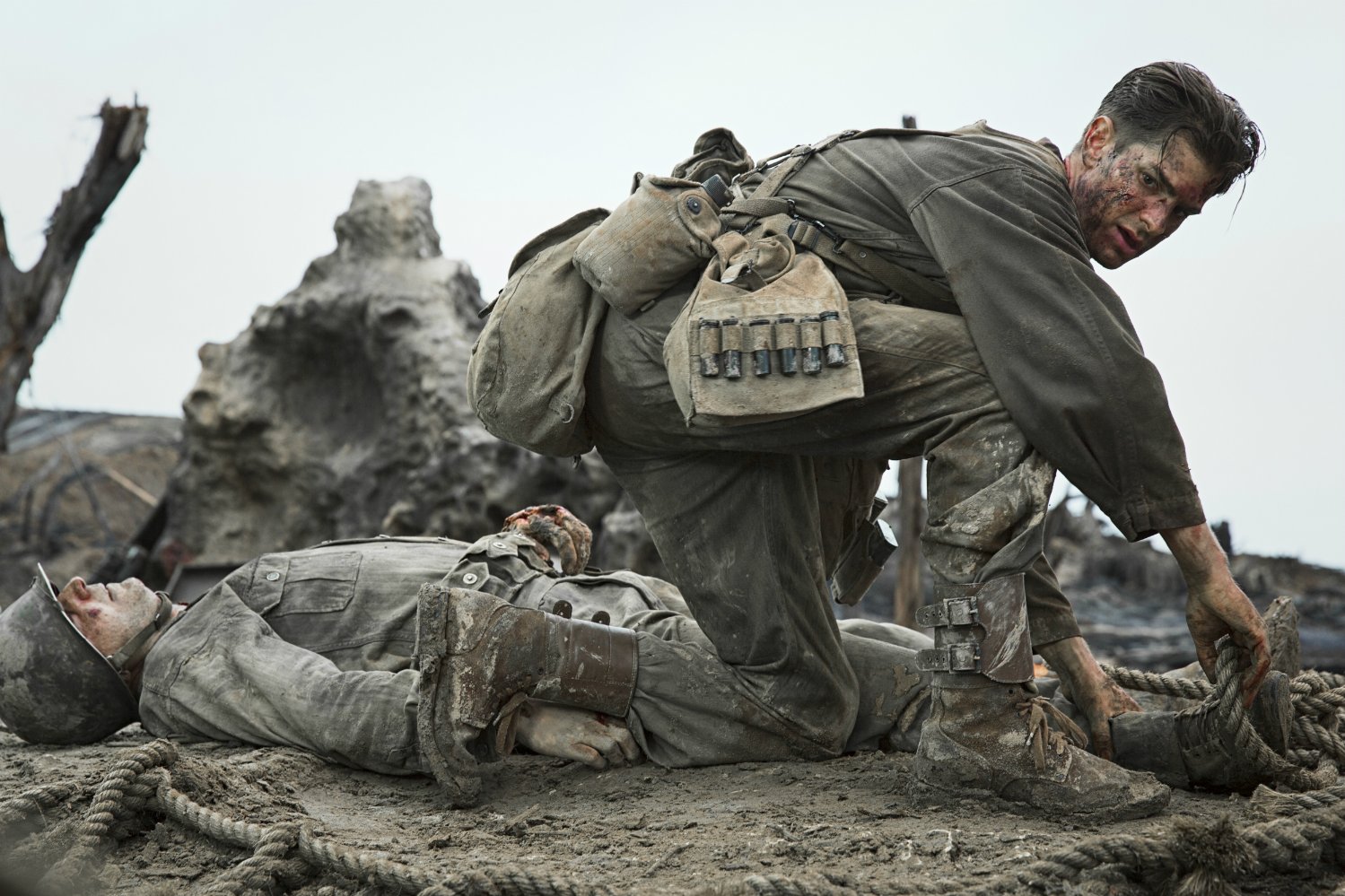

My Ratings: Moral rating: Excellent! / Moviemaking quality: 5